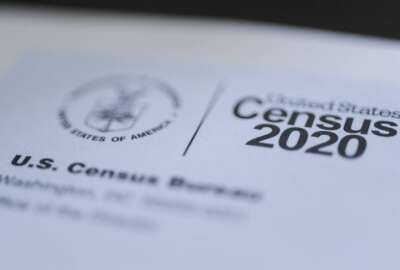Hubbard Radio Washington DC, LLC. All rights reserved. This website is not intended for users located within the European Economic Area.
On Air: Federal News Network
Trending:
Budget proposal fleshes out OMB’s management agenda
In the fiscal 2015 budget, the White House laid out initiatives that fall under each of the four pillars of the management agenda. The federal IT budget would d...
wfedstaff | April 17, 2015 6:21 pm
More than six months after President Barack Obama announced his second-term management agenda, the Office of Management and Budget is putting some specifics behind it.
As part of the fiscal 2015 budget request sent to Congress Tuesday, the administration described initiatives around improving customer service at the IRS and the Social Security Administration. OMB also plans to fund and launch a civilian property realignment board and to include more funding for the National Science Foundation and the National Institute of Standards and Technology to make federally funded data more widely available.
OMB said it will also launch new and improved employee training programs and three pilot programs to enhance how agencies hire employees.
“The agenda is focused on delivering a 21st century government that is more effective, efficient and supportive of economic growth,” said Beth Cobert, OMB’s deputy director for management, Tuesday during a teleconference with reporters. “This is a living agenda and it is not restricted to the initiatives I’m outlining today. As we make progress, we will continue to identify and launch new initiatives and reforms that support the agenda’s mission.”
Cobert said the management agenda is focused on four themes:
- Effectiveness — delivering better, faster, smarter services to citizens and businesses.
- Efficiency — increasing quality and value in the government’s core administrative functions.
- Economic growth — opening government funded data and research to the public to spur innovation and economic growth.
- People and culture — unlocking the full potential of the federal workforce and building the workforce the government needs for the future.
Cobert said the budget proposals would provide “real and lasting change” to how the government works.
Throughout all of these initiatives, technology will continue to play a key role and enabler.
To that end, the administration is requesting $79.1 billion for federal IT, down from $81.4 billion in 2014. The Defense Department is responsible for most of the decrease — dropping to $35.4 billion in 2015 from $37.6 billion in 2014. The IT budget for civilian agencies remains roughly the same, at $43.7 billion. Included in that topline figure is more than $13 billion for agencies to spend on cybersecurity technologies, people and other resources in 2015.
Federal Chief Information Officer Steven VanRoekel said much of the decrease also can be attributed to savings from the use of the PortfolioStat program. Under that initiative, agencies are trying to reduce duplicative spending and consolidate commodity IT services.
VanRoekel pointed to the Small Business Administration as an example of how PortfolioStat is saving money. He said SBA will move its email, calendar and contacts to the cloud.
On the effectiveness front, the budget includes $100 million for the Social Security Administration for a new customer-service modernization initiative to significantly improve Internet and in-person services.
SSA also would receive another $150 million as part of the Opportunity, Growth, and Security Initiative to further reduce wait times and enhance services at SSA.
The Veterans Affairs Department would receive more money to invest in the eBenefits Web portal to improve how veterans manage their benefits. The budget calls for VA to receive $173.3 million for the Veterans Benefits Management System, which would be used to reduce processing time and the claims backlog, automate claims tracking and facilitate improvements to the quality of the claims processing.
Under the efficiency front, the White House is expanding ongoing initiatives and, once again, is requesting authority to submit proposals to reorganize the Executive Branch under a fast-track procedure.
Cobert said agencies reduced the improper payment rate to 3.5 percent in 2013. OMB is conducting a comprehensive analysis of agency-specific corrective actions to identify programs with the highest return-on-investment or potential for substantially reducing improper payments in order to help shape future guidance on improper payments.
Under the “Freeze the Footprint” initiative, the administration will begin publicly tracking the government’s adherence to a fixed baseline — 730.2 million total square feet — composed of office and warehouse space, and agencies will continue to pursue mobile workforce strategies and tighter internal controls on space acquisitions.
“In addition, the budget includes $57 million to start up the Civilian Property Realignment Act (CPRA),” the documents stated. “CPRA would create an independent board of private- and public-sector real-estate experts that would make recommendations to the Congress on properties that should be sold, consolidated, co-located or reconfigured.”
OMB submitted legislation to Congress in 2013 to create a civilian Base Realignment and Closure commission. The bill received attention from lawmakers, but was never passed out of Congress.
As part of its efforts to spur economic growth, the White House is proposing that the National Science Foundation develop a repository where the public can access articles by NSF-funded researchers.
At the same time, NIST would receive $6 million to accelerate and expand technology transfer across the federal government, which will enhance the competitiveness of U.S. industry by sharing innovations and knowledge from federal laboratories.
And finally under the people and culture piece of the agenda, the administration wants to develop governmentwide enterprise training and resource exchanges to share best practices and increase leadership development opportunities.
“The budget includes funding for the Office of Personnel Management to build a stronger onboarding program for new Senior Executive Service, and leadership and engagement training opportunities for current SES that emphasize diversity and the changing needs of a 21st Century workforce,” the documents stated. “Beginning in 2015, the administration will launch demonstration projects to identify promising practices in recruiting, hiring, onboarding, and deploying talent across agencies. The goal of these projects is to increase diversity, reduce skills gaps, and improve organizational outcomes.”
RELATED STORIES:
White House budget aims to boost federal employee pay, training
Agencies forced to freeze office space footprint
OMB says PortfolioStat’s impact measured by billions of dollars in savings
Obama proposes employee training improvements in 2015 budget
Copyright © 2024 Federal News Network. All rights reserved. This website is not intended for users located within the European Economic Area.
Jason Miller
Jason Miller is executive editor of Federal News Network and directs news coverage on the people, policy and programs of the federal government.
Follow @jmillerWFED





